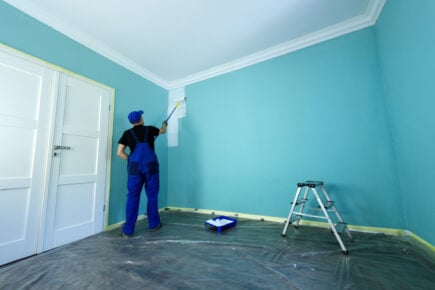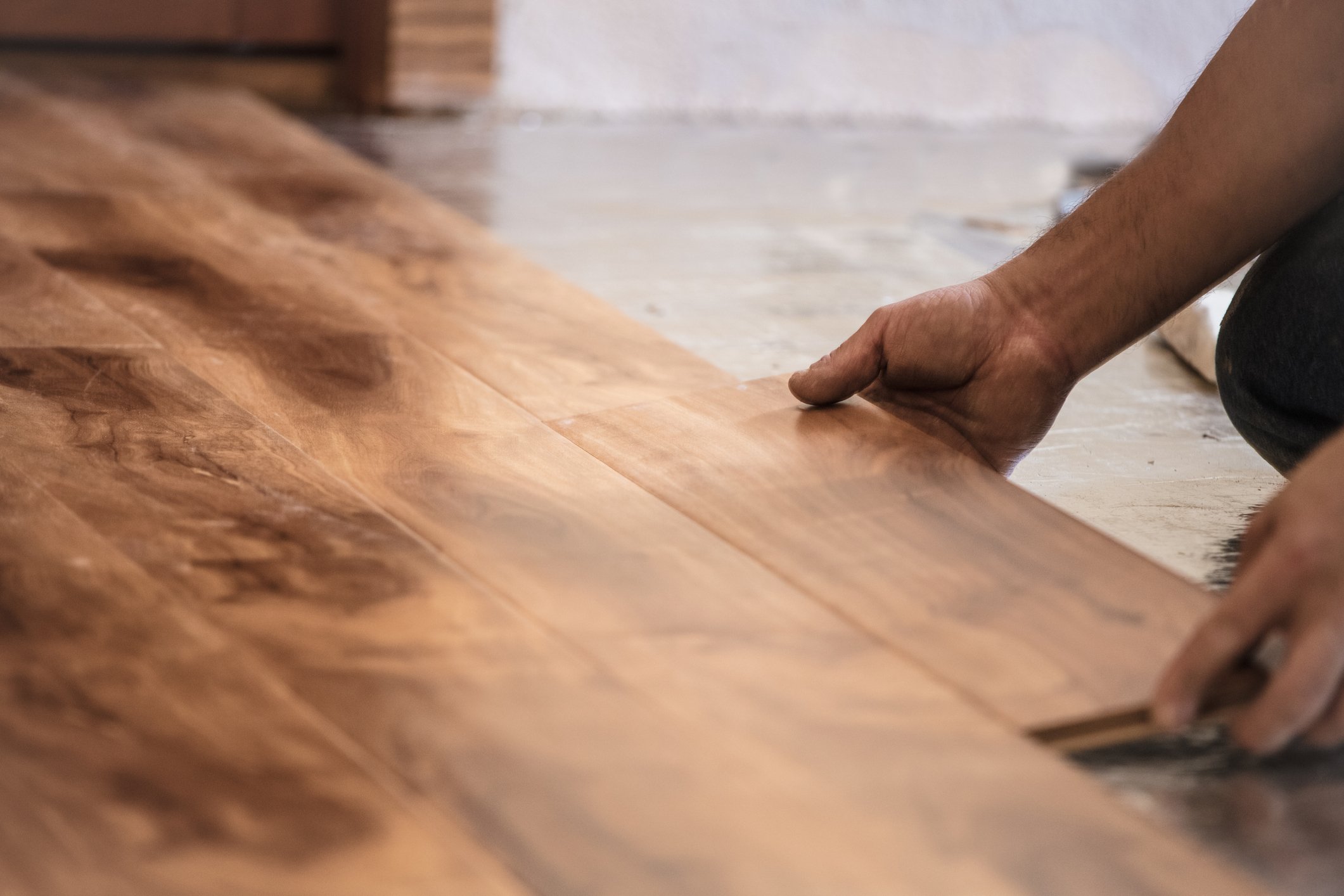Whether you’re a first-time home buyer or looking to renovate a house you’ve lived in for years, installing hardwood flooring may be on your to-do list. New floors can give your home an updated, fresh look and raise its market value. As a bonus, you don’t have to break the bank to install them.
How affordable your project is, however, will depend on the size of your home, the type of hardwood you choose and the work required to install it. Here’s what you need to know before getting started.
Hardwood floor installation costs
To get an idea of the potential cost of new hardwood floors for your house, multiply the prices below by the square footage you plan to cover.
| Type of flooring | Typical cost |
|---|---|
| Solid hardwood | $4 to $13 per square foot. |
| Engineered wood flooring | $5 to $16 per square foot. |
Price ranges reflect estimates sourced from sites like HomeDepot.ca[1], Rona.ca[2], ChestnutFlooring.ca[3], lvflooring.ca[4], and HomeStars[5]. Your hardwood flooring installation costs may vary.
Let’s say you want new flooring in a 1,000-square-foot area. You should expect to pay:
- $4,000 to $13,000 for solid hardwood.
- $3,000 to $16,000 for engineered wood.
Those costs only reflect materials, however. If you’re hiring someone to remove old flooring and put in new hardwood, labour could easily add another $3 to $4 per square foot, depending on your location. You may also have to purchase subfloor materials, which may cost up to $4 per square foot.
Factors that affect the cost of hardwood flooring
When researching hardwood flooring costs, there are several factors to consider that will affect your bottom line.
Type of wood flooring
Choosing the right type of wood for your project is important. For flooring installed at ground level or above grade, both solid and engineered hardwood can work well. Floors done below grade, such as in the basement, should generally be engineered hardwood since it’s more moisture-resistant.
Each type of wood has distinct properties and pros and cons:
Solid wood
Although it’s more expensive, solid wood is good for many rooms. The exceptions are locations that may be exposed to excess moisture, such as bathrooms, basements and kitchens. Solid wood comes straight from the tree, meaning it isn’t multiple pieces of wood held together with synthetic materials. This makes it sturdy. It’s also easy to sand and refinish.
Engineered hardwood
Engineered wood flooring is created by applying a real layer of wood on top of plywood or fibreboard, giving it the look of solid hardwood but at a lower price. Engineered hardwood is designed to withstand moisture, so it can be used in almost any room. In terms of limitations, only certain engineered hardwood can be sanded and refinished. So, if you want to refresh the look of your room down the line, it’s possible you might need to do a full replacement.
Wood species
Consider how you want your floors to look. The colour and grain detail is determined by the wood species you choose. Most species are also available in different gloss levels, from ultra matte to high gloss, which can affect the overall appearance.
The most common wood species for residential hardwood flooring include:
- Oak. This wood can come in red or white. Red oak is pinkish with dark grain lines. White oak is darker, with a mix of brown and tan grain lines, and it tends to be a bit more expensive than red.
- Maple. A good option for brightening up a home, maple flooring comes in warm colours with light grain lines. If you prefer a darker look, you can stain or dye it to the colour of your choice.
- Birch. Another light wood option is birch. What sets it apart from other types of wood is that it’s dimensionally stable, meaning it warps very little in response to moisture. This property makes it a good option for rooms like kitchens and bathrooms.
Size of flooring area
Because flooring is typically sold by the square foot, the bigger the floor space, the more you’re likely to pay. That said, if you’re covering a huge area, you might be able to buy your materials in bulk, which may help you save a bit on the cost of reflooring a large home.
Board size
Most solid hardwood flooring comes in boards that are 3 1/4 inches wide. Engineered wood floors typically come in a standard width of five to seven and a half inches. You can purchase boards that are narrower or wider — which could affect the price — but you might want to consult a flooring professional first. Weather conditions in your area may affect the durability of the boards, and you don’t want to waste money on wood that isn’t suitable for your project.
Other hardwood flooring costs to consider
Materials are just one line item in your renovation budget. You’ll need to account for additional costs, too, like finishing, subfloors and baseboards. Of course, you might be able to reduce some of these costs by doing the work yourself, but paying professionals can often deliver a faster, more polished result.
Labour
After materials, labour will likely be your biggest expense. Exactly how expensive it is will depend on your location, the complexity of your project, the square footage of the area and the professional’s experience. Installation may cost roughly $2 to $3 per square foot for click-and-install hardwood. You can expect to pay an additional $1 per square foot for hardwood that requires nails and glue to put in. That said, there’s no set rate for floor installation, so it’s a good idea to get a few quotes.
Removal of old floors
Preparing to install your new hardwood flooring usually requires you to remove your old floors and dispose of the old materials. The cost of removing the old flooring is usually included in an installation quote, but it’s a good idea to confirm. You may also get a small discount if you’re willing to remove all the old flooring yourself.
Subfloor preparation and installation
Before installing your new flooring, your contractor will need to assess the condition of your subfloors. If they require repairs, levelling or protection from moisture, you can expect to spend more. The average cost for subfloor materials is about $0.50 to $4 per square foot.
Finishing
Hardwood floors come prefinished or unfinished. Prefinished flooring has had finishing coats applied at the factory and typically costs more than unfinished boards. Unfinished flooring is cheaper, but will need to be finished once it’s installed, which could add to your labour costs.
Trims and baseboards
Many homeowners will install trim or baseboards along with their new hardwood flooring. Trim creates a transition from hardwood to another type of flooring, like carpet, and from the floor to the walls. In addition, trim can cover any expansion gaps. Trims and baseboards aren’t expensive, but installing them will require additional labour.
Location and type of home
Your home’s location will affect your costs. If you live in a rural area, your contractor may charge for additional travel time. Some cities, on the other hand, may have higher contractor fees due to a higher cost of living. Additionally, if you live in a condo or apartment, you may have to pay more for labour, as your installers will likely have to make multiple trips up and down your building’s stairs or elevator.
Supply chain
Hardwood floors require lumber, and the price of lumber can fluctuate depending on supply chain issues. When there’s a lot of demand and limited supply, prices go up. Whenever there’s limited demand or excess supply, prices tend to drop.
Ongoing maintenance and cleaning
Hardwood floors require some routine maintenance. You’ll want to vacuum and mop your floors regularly, and use a special hardwood cleaner once a month. A new coat of finish is recommended every three to five years. You can also sand and refinish your floors every 10 years.
Hardwood flooring alternatives to consider
If hardwood flooring is not within your budget, or you prefer something different, you could consider one of these other flooring options:
- Cork. Not only is cork comfortable to walk on, but it also absorbs sound.
- Vinyl or laminate. These flooring materials offer the look of hardwood at a much lower price.
- Tile. Often used in kitchens, bathrooms, laundry rooms and mudrooms, tile is durable and resistant to moisture.
- Bamboo. Durable and sustainable, bamboo can also give you the look of hardwood.
- Carpet. An inexpensive option that’s soft to the touch and has multiple design options.
Frequently asked questions about hardwood flooring costs
Many homeowners consider installing hardwood floors to be worth the investment. Installing new hardwood floors instantly gives your home a fresh look and can increase your property value if you ever decide to sell. Whether hardwood floors are a good choice for your home is ultimately a decision based on your preferences, budget and lifestyle.
From a cost and quality perspective, solid wood is considered the best hardwood flooring. However, the best option for you depends on where you’ll be installing it and what your overall goals are for the space. Generally, the best hardwood floors are the top quality you can afford within your budget.
Article Sources
-
Home Depot Canada, “Solid Hardwood Flooring,” accessed July 10, 2024.
-
RONA, “Solid Wood Flooring,” accessed July 10, 2024.
-
Chestnut Flooring, “Flooring Calculator,” accessed July 10, 2024.
-
LV Hardwood Flooring, “How much does Hardwood Flooring Cost in Canada in 2022,” accessed July 10, 2024.
-
HomeStars, “Guide to Flooring Costs & Estimates in Canada,” accessed July 10, 2024.
DIVE EVEN DEEPER

The Best Mortgage Rates in Canada
Quickly explore Canadian mortgage rates from bank and non-bank lenders. Find the best fixed or variable mortgage rate for your home buying needs.

Mortgage Payment Calculator
Use our mortgage payment calculator to estimate your monthly mortgage payments in Canada. Enter your loan details to get an accurate and quick assessment of your mortgage costs.

Cost to Paint a House in Canada
Size and condition of your home, the type of paint you choose and the cost of labour in your area all affect the cost to paint a house.

Inground Pool Cost in Canada
Dreaming of swimming in your own backyard? Here’s what an inground pool could cost to install — plus, the hidden costs you’ll want to factor in.

